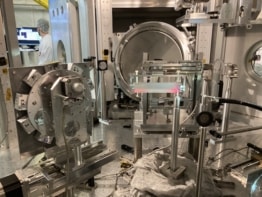The applications of wire-array “Z-pinches” are experiencing a renaissance. In recent years, researchers at Sandia in the US, Imperial College in the UK, and the Troitsk Institute in Russia, among others, have managed to perfect the art of using ultrashort current pulses to produce an intense source of X-rays. Such a source can be used to drive thermonuclear fusion, to simulate the plasmas that are found near the surface of neutron stars, or to produce jets similar to those in astrophysical phenomena.
In a Z-pinch experiment, a plasma is generated by passing a short pulse of extremely high current – between 1 and 20 MA – in the z direction through a cylindrical array of thin metal wires. The current vaporizes the array and produces a strong magnetic field around the plasma, which compresses it at high velocity in the radial, or r, direction. The density and temperature of this “pinched” plasma are such that it generates total X-ray radiation yields of more than 1MJ.
The currents that power the Z-pinches are produced by large electrical pulsed systems, consisting of gymnasium-sized rooms filled with high-voltage capacitor banks and transmission lines, all immersed in huge tanks of oil and water for insulation purposes (see Physics World May 2003 p6).
Z-pinches driven on a timescale of 100 ns are sometimes referred to as fast Z-pinches. This is because they can create a plasma on a timescale that is quicker than it takes for plasma instabilities to grow, which can reduce the radiated power of the pinch. Now Farhat Beg of the University of California at San Diego, Karl Krushelnick, Bucker Dangor and colleagues at Imperial College, in collaboration with Eugene Clark of the Atomic Weapons Establishment and Peter Norreys of the Rutherford Appleton Laboratory, have produced a fast single-wire Z-pinch that is driven on a timescale of about 100 ps (100 x 10–12 s).
Furthermore, in contrast to conventional means of driving currents using large capacitor banks and low-inductance transmission lines, the team produced a “micro” Z-pinch drive current using a novel and extremely compact method: a high-intensity focused laser (Phys. Rev. Lett. 92 095001).
In the May issue of Physics World Michael E Cuneo at Sandia National Laboratories in Albuquerque in the US describes this work in more detail.


